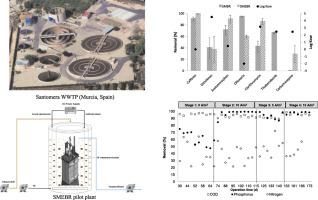Journal of Environmental Chemical Engineering ( IF 7.4 ) Pub Date : 2020-12-02 , DOI: 10.1016/j.jece.2020.104874 Lyvia Mendes Predolin , M.J. Moya-Llamas , Edgardo David Vásquez-Rodríguez , Arturo Trapote Jaume , Daniel Prats Rico

|
Submerged membrane bioreactors (SMBR) are widely known for their advantages in the field of wastewater treatment. However, despite the significant technological advances in recent decades, membrane fouling remains one of the major concerns for its efficient application. Recent studies, carried out with synthetic wastewater, show that the integration of electrochemical processes as electrocoagulation with membranes technologies provides promising advantages. This research focuses on the performance of a pilot-scale membrane electro-bioreactor (SMEBR) treating real wastewater with an average organic loading rate of 0.91 ± 0.44 mg/L COD from a municipal wastewater treatment plant). Current densities of 5, 10, and 15 A/m2 (charge loading of 214.17, 428.34 and 642.42 mA m−3·h respectively) and exposure time of 5′ON/10′OFF were applied to compare the efficiency of the SMEBR system versus the SMBR. The removal efficiencies of COD, nutrients (total nitrogen and total phosphorus) and 10 selected micropollutants (8 pharmaceuticals and 2 pesticides) were studied. The results showed that the SMEBR system improved the treated effluent quality in comparison with the SMBR, mainly regarding phosphorus, increasing its elimination by an average of 34.6%, and the micropollutants acetaminophen, clarithromycin and carbamazepine, which presented an average increase in the removal rates of 19%, 43% and 28%, respectively, comparing with those obtained in the SMBR. The optimal operational conditions were obtained when a current density of 5/A/m2 was applied. At this stage, the SMEBR showed a significant reduction in the membrane fouling, achieving reductions rates in transmembrane pressure and extracellular polymeric substances of 72.8% and 55.5%, respectively.
中文翻译:

电流密度对膜电生物反应器去除微量污染物和磷以及减少结垢效率的影响:中试工厂案例研究
浸没式膜生物反应器(SMBR)以其在废水处理领域的优势而广为人知。然而,尽管近几十年来技术取得了重大进步,但膜污染仍然是其有效应用的主要问题之一。最近对合成废水进行的研究表明,将电化学过程(如电凝法)与膜技术相结合具有可观的优势。这项研究的重点是中试规模的膜电生物反应器(SMEBR)在处理市政废水处理厂的平均有机负载率为0.91±0.44 mg / L COD的实际废水时的性能。电流密度为5、10和15 A / m 2(电荷负载为214.17、428.34和642.42 mA m -3分别使用·h)和5′ON / 10′OFF的曝光时间来比较SMEBR系统和SMBR系统的效率。研究了COD,养分(总氮和总磷)和10种选定的微污染物(8种药物和2种农药)的去除效率。结果表明,与SMBR相比,SMEBR系统改善了处理后的废水质量,主要涉及磷,其去除率平均提高了34.6%,对乙酰氨基酚,克拉霉素和卡马西平等微污染物的去除率平均提高了与SMBR相比,分别为19%,43%和28%。当电流密度为5 / A / m 2时,可获得最佳操作条件已应用。在这一阶段,SMEBR膜的结垢明显减少,跨膜压力和细胞外聚合物减少率分别降低了72.8%和55.5%。









































 京公网安备 11010802027423号
京公网安备 11010802027423号